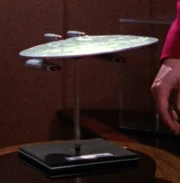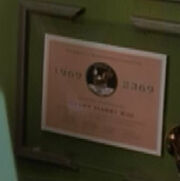Renegade54 (talk | contribs) m (formatting) |
FleetCaptain (talk | contribs) (launch time) |
||
| Line 9: | Line 9: | ||
| image2= Apollo 11 library file.jpg |
| image2= Apollo 11 library file.jpg |
||
}} |
}} |
||
| − | '''''Apollo 11''''' was an [[American]] [[Apollo program|Apollo Program]] [[spacecraft]] that was in service with [[NASA]] in the mid-[[20th century]]. This craft carried three [[astronaut]]s to the moon. ''Apollo 11'' was launched atop a ''[[Saturn V]]'' [[rocket]] from [[Cape Kennedy]]. The |
+ | '''''Apollo 11''''' was an [[American]] [[Apollo program|Apollo Program]] [[spacecraft]] that was in service with [[NASA]] in the mid-[[20th century]]. This craft carried three [[astronaut]]s to the moon. ''Apollo 11'' was launched atop a ''[[Saturn V]]'' [[rocket]] from [[Cape Kennedy]]. The original launch time was set for 6AM [[Eastern Standard Time]]. ({{TOS|Tomorrow is Yesterday}}) |
| + | |||
| + | ''In reality, Apollo 11 launched shortly after 1:30 in the afternoon'' |
||
| + | |||
| + | The lunar landing took place on July 20, 1969, at [[Tranquility Base]]. This mission was the first in the Apollo Program to succesfully land [[human]]s on [[Luna]]. ({{TOS|Tomorrow is Yesterday}}) |
||
{{bginfo|The names of the three [[astronaut]]s were [[Buzz Aldrin]], [[Neil Armstrong]], and {{w|Michael Collins (astronaut)|Michael Collins}}. Unlike Aldrin or Armstrong, Michael Collins was never mentioned or referred to in ''Star Trek''.|The reference to ''Apollo 11'' in "Tomorrow is Yesterday" is an oblique one – a [[radio]] report referring to the launch of the first moon landing mission on "[[Wednesday]]". Despite being written over two years prior, the reference coincidentally gives the same launch day as actually occurred, with the launch time only off by seven hours.}} |
{{bginfo|The names of the three [[astronaut]]s were [[Buzz Aldrin]], [[Neil Armstrong]], and {{w|Michael Collins (astronaut)|Michael Collins}}. Unlike Aldrin or Armstrong, Michael Collins was never mentioned or referred to in ''Star Trek''.|The reference to ''Apollo 11'' in "Tomorrow is Yesterday" is an oblique one – a [[radio]] report referring to the launch of the first moon landing mission on "[[Wednesday]]". Despite being written over two years prior, the reference coincidentally gives the same launch day as actually occurred, with the launch time only off by seven hours.}} |
||
Revision as of 02:52, 12 May 2013
Apollo 11 was an American Apollo Program spacecraft that was in service with NASA in the mid-20th century. This craft carried three astronauts to the moon. Apollo 11 was launched atop a Saturn V rocket from Cape Kennedy. The original launch time was set for 6AM Eastern Standard Time. (TOS: "Tomorrow is Yesterday")
In reality, Apollo 11 launched shortly after 1:30 in the afternoon
The lunar landing took place on July 20, 1969, at Tranquility Base. This mission was the first in the Apollo Program to succesfully land humans on Luna. (TOS: "Tomorrow is Yesterday")
The Apollo 11 lunar landing was shown on TV, a broadcast that the "whole world" had watched. Shannon O'Donnell was eleven years old at the time, and later recalled watching the landing on TV, and would also have dreams recalling Armstrong's famous words: "That's one small step for [a] man, one giant leap for mankind." In 2000, O'Donnell shared her moon landing experience with Jason Janeway, who himself had seen it once in science class. (VOY: "11:59")
In 2143, a mission patch for this mission was seen in the 602 Club. (ENT: "First Flight")
When James T. Kirk argued in favor of having Sargon and his companions take over the bodies of the crew, in 2269, and emphasized the benefits that it might possibly have on mankind, he explained, "they used to say if man could fly, he'd have wings. But he did fly. He discovered he had to. Do you wish that the first Apollo mission hadn't reached the moon or that we hadn't gone on to Mars or the nearest star?" (TOS: "Return to Tomorrow")

A Nebula-class starship model with the Apollo 11 lunar lander
In 2367, in Barash's fictional 2383, Captain William T. Riker had a model of the Apollo 11 lunar lander next to a model of a Nebula-class starship. (TNG: "Future Imperfect")

A certificate was awarded to Cadet Harry Kim in 2369 while he was still at Starfleet Academy, related to the Apollo 11 quadricentennial. When temporarily given command of Medical Transport 136 (aka Nightingale) he felt this award was important enough to be one of the few things he brought along for his ready room, including his saxophone and his Academy diploma. (VOY: "Nightingale")
In an alternate timeline where Kim had not been assigned to USS Voyager, he also had the certificate in his office at Starfleet Command in 2372, along with his diploma. (VOY: "Non Sequitur")
In 2375, a crewman was researching the Apollo 11 mission in the USS Enterprise-E's library. (Star Trek: Insurrection)
Appendices
Background information
The three launch components of this mission were the command/service module Columbia (NSSDC ID: 1969-059a), the third stage of the Saturn V rocket (NSSDC ID: 1969-059b), and the lunar module Eagle (NSSDC ID: 1969-059c). The command/service module's name Columbia was later reused for a space shuttle and several civilian and Starfleet starships in the Federation. These include the Columbia NX-02, SS Columbia, and the USS Columbia. Likewise, the Federation starship USS Eagle was named in honor of the lunar module Eagle.
